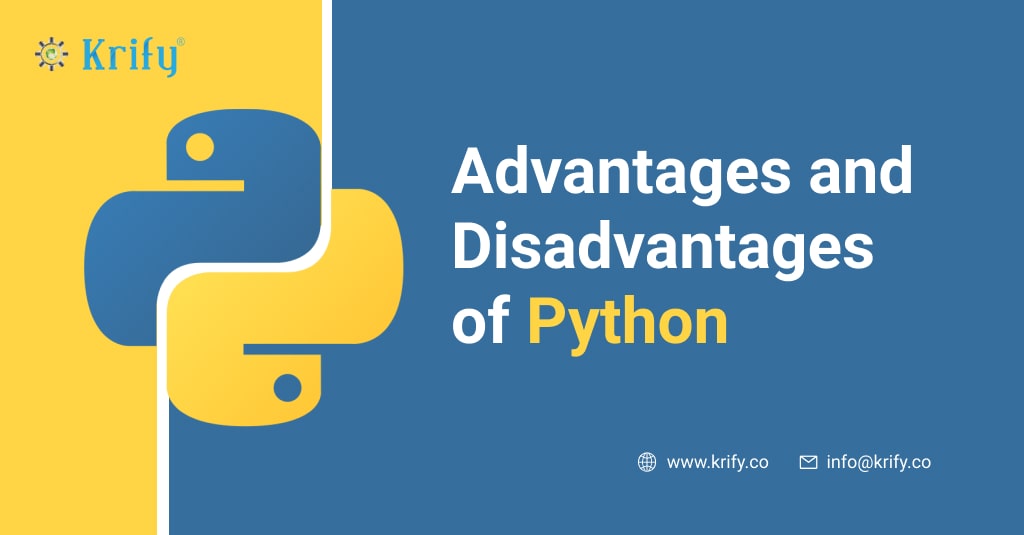What is Python?
Python is a high-level, interpreted general-purpose programming language. Its code readability is enhanced by significant indentation, according to its design philosophy. Its constructs and object-oriented approach are designed to help programmers write clear, logical code for small and large projects. When learning a new language you must know the pros and cons, you must first be aware of the advantages and disadvantages of Python.
This will assist you in gaining a deeper understanding of how to make the most of the Python programming language. We can construct robust applications by knowing about the advantages and disadvantages of Python. Let’s start with the good things about Python and work our way down to its flaws.
Advantages of Python
- Simple to Write, Read, and Learn
- Improved Productivity
- Language Interpretation
- Typed Dynamically
- Free and Open-Source Software
- Huge Library Support
- Adaptability
1. Simple to Write, Read, and Learn:
Python is a high-level programming language with English-like syntax. This makes it simpler to read and comprehend the code. Python is extremely simple to learn and use, which is why many people advocate it to newcomers. To execute the same operation as in other prominent languages like C/C++ or Java, you need fewer lines of code than in others such as C/C++ or Java.
2. Improved Productivity:
Python is a highly productive language. Developers can concentrate on fixing the problem because Python is so easy to use. They don’t have to spend much time learning the syntax or behavior of the programming language. You write less code and accomplish more tasks than in other languages.
3. Language Interpretation:
Python is an interpreted language, which means that it executes the code line by line. When an error occurs, Python stops execution and reports the problem to you. Even if there are multiple problems with the program, Python only displays one error. This makes debugging considerably simpler.
4. Typed Dynamically:
Python doesn’t know the kind of variable until the code is run. During execution, it assigns the data type depending on what’s entered. The programmer need not worry about defining variables and their data types.
5. Free and Open-Source Software:
Python is licensed under the OSI-approved open-source license. This allows you to use and distribute Python freely. You can download the source code, modify it, and even offer your own version of Python. This is beneficial for businesses who wish to change a certain aspect of Python and build on it for development purposes.
6. Huge Library Support:
Python’s standard library is huge, and you can find almost all of the functions you’ll need for your job there. As a result, you won’t have to rely on third-party libraries. However, even if this is the case, the Python package manager (pip) makes importing other excellent packages from PyPi much easier.
7. Adaptability:
In many programming languages, such as C/C++, you must modify your code in order to run the program on different operating systems. That is not the case with Python. You only write once and may distribute it to anyone. However, you should avoid including any system-dependent capabilities.
Disadvantages of Python
- Slow Execution
- Low Memory
- Database Access
- Runtime Errors
1. Slow Execution:
We’ve previously established that Python is an interpretive and dynamically typed language. Code execution frequently takes too long. Because Python has to do additional work when executing code, it is not suited for applications where speed is a critical component of the project. So, because Python needs to perform further operations while executing code, it’s not suitable for projects that need fast results.
2. Low Memory:
To make things easier on the developer, Python has to make some compromises. Python is a memory-consuming programming language. When we want to improve application performance, this might be an issue.
3. Database Access:
Python programming is simple and stress-free. When we interact with the database, though, it falls behind. In comparison to popular technologies like JDBC and ODBC, Python’s database access layer is limited and rudimentary. Python is seldom used in businesses owing to its poor interaction between complex legacy data and the language.
4. Runtime Errors:
As we all know, Python is a dynamically typed language, so the data type of a variable may change at any moment. A variable containing an integer number might later contain a string and result in runtime errors. As a result, Python developers must do extensive testing on their programs.
Conclusion:
Python is a simple, flexible, and comprehensive programming language. you have seen a few advantages and disadvantages of Python. It’s an excellent starting point for novices as well as experts. Although it has some drawbacks, the benefits outweigh the disadvantages. Python was one of Google’s primary programming languages even before it was developed.
We at Krify have a team of well-versed developers that are experts in their field. As a Multinational firm, we embrace the latest technology and trends in developing robust mobile and web applications. If you’re looking for a Python developer in India, you’ve come to the correct spot. For further information, please contact us.




